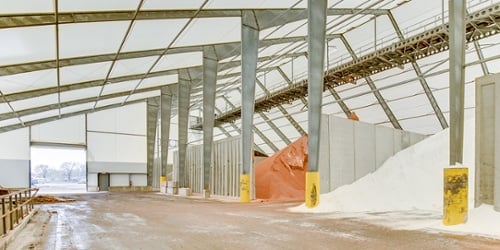Why Your Next Industrial Structure Should Be Fabric

Our President/CEO, Ben Fox, recently spoke with engineering.com about the benefits of fabric structures for industrial use.
When most people think of fabric buildings, they think of tents and pavilions—structures that serve important but ultimately temporary functions.
What they probably don’t imagine are structures that give pre-engineered metal buildings a run for their money.
The engineering behind a fabric building is nearly identical to its metal equivalent; the only major difference is that the former uses fabric cladding rather than metal.
The technology underlying fabric structures has evolved considerably over the last few decades, but many civil and structural engineers may be unaware of just how far they’ve come.
Fabric Structure Durability
“The fabric is a lot tougher than people realize,” said Ben Fox, president of Legacy Building Solutions. “From 12-ounce all the way up to 32-ounce and from polyethylene to PVC, there are a lot of different fabrics, and each has its own pros and cons.” Legacy's exclusive ExxoTec(TM) fabric is a 28-oz PVC fabric.
A natural question to ask of a fabric structure concerns its resistance to tearing. Will a careless employee with a box cutter sticking out of his pocket end up tearing a hole through the side of your building? Definitely not.
“It takes a lot of pressure to cut the fabric, so it’s not going to happen by accident,” said Fox. “It’s by nature a very tough material and very easy to repair if that’s needed.”
How do you repair a fabric structure?
“Our fabric is made in individual panels—typically 20 feet wide—and attached individually to the frame. One of the benefits of that is that the panels can be individually replaced. It’s a lot less inconvenient and costly for the customer.”
Fabric Structure Longevity
Properly engineered and constructed, fabric cladding has a minimum life span of 20 years. The right coatings can push that into the 30-year range, but it’s more than just the material properties of the fabric that account for this already surprising lifespan.
“One of the keys to the longevity of the fabric cladding is to get proper tension on it in both directions: vertically and horizontally,” said Fox. “We call it biaxial tension. If the fabric’s properly tensioned, that’s when you get the longest lifespan.”
Fox described fabric structures in terms of three key aspects: the metal framing, the fabric, and the attachment of the two. “You can have great engineering and great fabric, but if you don’t attach it properly, it won’t last,” Fox added that the steel frame has a lifespan of 50 years or more, as is typical with other solid-framed buildings.
Fabric Structure Size and Flexibility
Although corrosive storage is the most common use for fabric buildings, other industries have started to take advantage of the benefits and customization fabric buildings offer.
“We’re doing a lot of recreation structures for indoor sports, like tennis and football,” said Fox. “We do a wide variety of industries: from aviation, where you need large spans with large doors, to casinos, where you need a clean and fairly airtight environment.”
In fact, fabric structures are more airtight than their pre-engineered metal counterparts. “HVAC specialists are used to finding ten to fifteen percent air leakage in metal structures, but they only find one to four percent in ours,” said Fox.
Does Fabric Beat Metal for Pre-Engineered Structures?
Fabric structures have come a long way in recent years. They offer all the benefits of metal structures when it comes to durability, longevity, and flexibility. Fabric buildings have a strong advantage over pre-engineered structures: they can be erected faster and at a typically lower cost.
“By the time you include construction, we’re the same price to 20-30 percent less than conventional [metal] structures,” said Fox.
Subscribe to our Blog
Recent Posts
- 5 Factors Every Project Owner Should Consider Before Approving Building Materials
- The 20-Year View: How Material Choices Impact Long-Term Operational Costs
- Climate Resilience in Commercial Construction: Why Traditional Methods May Not Be Enough
- Speed and Quality: The Role of Hybrid Building Materials
- Beyond the Bleachers: Designing Visually Striking Sports Facilities

